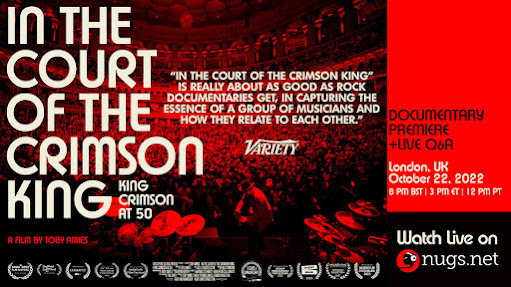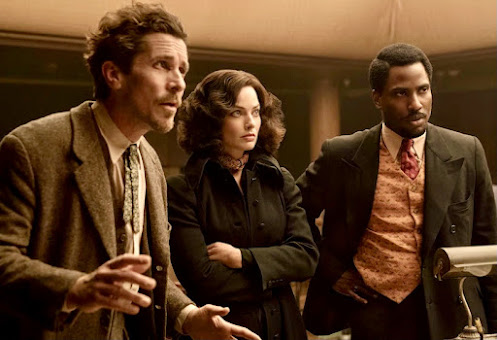Now playing at a multiplex or arthouse near you:
AMSTERDAM (Dir. David O. Russell, 2022)
To say that it started out so richly promising, but then got all screwy could go for this movie, and for David O. Russell’s entire filmmaking career. After making a minor splash back in the ‘90s with such offbeat comedies as SPANKING THE MONKEY, and FLIRTING WITH DISASTER, then making a breakthrough with THREE KINGS, Russell has built a reputation for abusive behavior on his sets.
Tales have run rampant of Russell head-butting George Clooney in a fight while shooting THREE KINGS, and verbally berating Lily Tomlin (calling her the C-word in a video you can still find on YouTube), and Amy Adams on I HEART HUCKABEES, and AMERICAN HUSTLE respectively. However, Christian Bale, Jennifer Lawrence, and even Tomlin herself have made more than one film with him so there’s that.
Then there’s the allegations of sexual assault involving his 19-year old trans niece, so, yeah, Russell has baggage, and he’s never been a favorite filmmaker of mine. But I’ve liked some of his films albeit in a fairly superficial way, as they are usually visually appealing, have fine casts, and zippy narratives. I haven’t felt that they’ve added up to vital cinematic statements, and I sure don’t see that in his latest offering, the so-called mystery comedy thriller, AMSTERDAM, which stars Bale, Margot Robbie, and John David Washington as a trio of World War I combat vets, who come together in 1933 to foil a fascist plot to overthrow the U.S. government.
Bale is undoubtedly the lead protagonist as he anchors nearly every scene as the crochety Dr. Burt Berendsen, a war veteran with a prosthetic eye. It’s another fully realized Bale character, and he’s a joy to watch fumbling through the film, whether lovelorn over his estranged wife Beatrice (Andrea Riseborough), or bantering with Washington as his best pal lawyer, Harold Woodsman, who glides through the movie’s snazzy set-pieces with his smooth, dapper demeanor.
Rounding out the triad that recalls the trios of hipster friends in obvious Russell touchstones as FrançoisTruffaut’s JULES AND JIM, and Jean-Luc Godard’s BAND OF OUTSIDERS, is Robbie, working those saucer eyes as nurse Valerie Voze, who Bale’s Burt, and Washington’s Howard first meet in 1918 WWI, and re-unite in Manhattan in 1933.
The complex, or clunky (or both) plot mechanics, housed in a lot of talky exposition, involve the murders of General Bill Meekins (Ed Begley Jr.) and his daughter Liz (Taylor Swift), and a political scandal with a surprisingly invested Robert De Niro as General Gil Dillenbeck, who is based on real-life figure, Major General Smedley Butler, keying into the film’s opening declaration that “A lot of this actually happened.”
Russell has amassed a film full of stars as we’ve got a straight faced Chris Rock as another war buddy turned legal associate, an elegant Zoe Saldaña as a coroner /possible love interest for Burt, Michael Shannon, and Mike Myers as bird-watching spies (my favorite characters); and a wonderfully smarmy Rami Malek, and an an amusing uppity Anya Taylor-Joy as Valerie’s wealthy, snobby brother Tom, and his wife Libby.
When the strands of the narrative, which is based on the 1934 “Business Plot,” a scheme hatched to overthrow the democratic government in place of a dictatorial regime, lead to a messy reveal that somehow doesn’t have its intended impact, the film’s capering falls short of the cleverness it’s straining for.
Misguided moments abound, like a fantasized shooting of someone because they’re annoying gag, and a number of attempts at Coen brothers-style comic set-ups that don’t pay off, so the film falls short of a romp, but it still has a likable bounce to it as the camera of master cinematographer Emmanuel Lubezki crisply bops around the nifty New York-period sets, courtesy of designers, Patricia Cuccia, and Erin Fite.
I consider Russell’s AMSTERDAM to be only mildly problematic, because it’s a light endeavor thats ambition feels like an afterthought after all the polished stylings have gone through their paces. Much like AMERICAN HUSTLE, the film is style over substance, but it can be quite enjoyed on that surface level. Bale’s performance alone makes it worth seeing, and there are other considerable artistic merits such as its great visuals, so if you don’t try to dig too deep, or expect a mind-blowing history lesson, you’ll get a decent, but disposable time at the picture show.
More later...





%202.jpeg)


